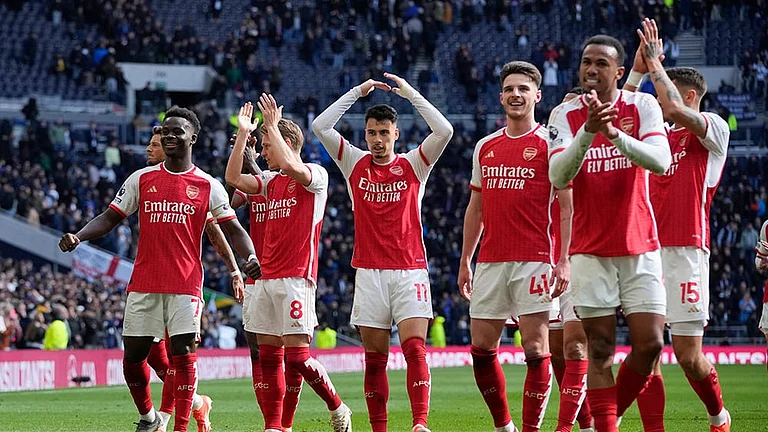The scorching heat in March and April—officially the spring season in North India—seemed quite unusual to Hakam Yadav, a farmer in Madhya Pradesh’s Shivpuri district. He, like many other farmers of the area, had sown onion—in the hope that like last year, he will get a good crop. But to his dismay, this didn’t happen. A heatwave—a period of excessively hot weather surpassing the average temperature of a region by 4.5°C to 6.4°C–shattered his dreams, as he didn’t get even half of the output he usually gets.
Dejected by the uncertain weather, Yadav said, “On a few occasions like last year, the weather is predictable. But often, uncertain rains and dry spells in summer create huge problems for us.”
ALSO READ: Poetry: Letter From A Former Cook
This year, he says, “Onion seedlings alone cost me around Rs 4,000. I’ve spent over Rs 25,000 on the crop. I was hoping I’d be able to harvest at least three trolleys of onions from my three bigha (1.8 acre) farm. But my crop wasn’t even half that.”
Like Yadav, another farmer, Shivcharan Dhakad, also faced the brunt of the inclement weather. He explained how this year, heat destroyed his crop: “The onions in the middle of my plot, where exposure to heat is high, were very small, compared to those that were planted on the sides, which had more shade.” But overall, the crop is poor.
ALSO READ: Dante’s Peak: Heatwave Horror In Photos
“Even farmers who could avail regular water supply suffered losses, though their loss was 10-20 per cent lower than ours,” says Dhakad. For farmers like him, the heatwave came as an unexpected shock, for which he wasn’t adequately prepared. Dhakad said he neither has any arrangement to create shade to reduce exposure of his crop to heat, nor knowledge of how to achieve it. He doesn’t even have tubewells for irrigation.
In Punjab too, a relentless heatwave has affected wheat and potato production. India is the second-largest wheat producer in the world. Many farmers in the state told Outlook that their production was affected by 30-50 per cent. Across India, the maximum average temperature in March was 33.1°C—making it the hottest in 122 years. By April, this went up to 45°C in many places.
Parvinder Singh Saini, a farmer from Balahri village of Fatehgarh Sahib district of Punjab, said along with the heat, unseasonal rains in January and February affected the wheat crop. “When it rained just after we sowed wheat, it stifled the growth of the wheat berry. And the heatwave in March and April that followed did the rest of the damage.” Saini adds, “Farmers who used to get 20-25 quintal are now harvesting 9-15 quintal.”
March-April is harvest time of Rabi (winter) crops—grown between November and April—such as wheat, barley, peas, gram and mustard. The damage caused to agriculture by the heatwaves is multi-dimensional. It has not just affected the food supply for humans, but also the support it gives to allied activities like cattle rearing. “Wheat stalks, which are used as cattle fodder, shrank. If a farmer was getting two trolley-loads of wheat stalks, now they have only one,” adds Saini.
Saini also says that the unexpected heatwave also caused a pest attack, which in turn “forced us to use pesticides to avoid crop damage”. Excessive use of fertilisers and pesticides affects the quality of food, which makes people— especially the poor—more susceptible to climate change threats.
The extreme heatwave, coupled with inflation, has attacked farm income directly. Bhairav Singh, a farmer in Jaipur’s Kotputli division, regrets sowing musk melon in spring. “Farming is overall risky. The weather is uncertain. We sow vegetables and fruits in spring, hoping that it will get us some money till the sowing season for maize or bajra arrives. I’d planted musk melon and vegetables. But the crop was barely enough to feed my family.”
Yadav, who is a marginal farmer with only two acres of land, has to labour on other farms for extra income. He says rising food prices and the heatwaves have throttled his existence. “Everything is expensive, from petrol to vegetables. There is no other income source here, barring manual labour. If I fall ill, my family won’t even have two meals.”
The United Nations Intergovernmental Panel on Climate Change published the second instalment of its Sixth Assessment Report (AR6) in February 2022, which says that climate change is making the poor more vulnerable to risk. “Many low-income residents live in informal settlements alongside coasts or rivers, which greatly heightens exposure and vulnerability to climate-driven hazards.” One event linked to climate change is the heatwave causing havoc in South Asia.
The UN Secretary-General António Guterres called the report an “atlas of human suffering” and blamed failure of climate leadership for putting half the world in the danger zone.
The frequency of extreme weather events like floods and drought, coupled with other challenges like falling water quality and water scarcity, are exacerbating the crisis. Farmers living in the hinterland and the urban poor living in low-income settlements face its brunt. Most farmers lack knowledge and resources to adapt to the climate crisis, while world leaders still can’t consider climate change as an unavoidable threat.
A report, Heat Waves, Climate Change, and Economic Output, published in Journal of European Economic Association last year, examined global datasets from 1979 to 2016 to show agronomy losses from past heatwaves. It warned that damage to agriculture can be 5-10 times over what is being predicted by mean temperature shift—an average of minimum and maximum temperatures.
ALSO READ: The Ides Of March: Heatwave Strikes
Food security is becoming a huge concern. A 2020 report of the UN’s Food and Agriculture Organization (FAO), says, “Up to 8.9 per cent of the world’s population is hungry—up by 10 million in a year, and by nearly 60 million in five years.” It strikes at the heart of the UN’s own Sustainable Development Goal of achieving zero hunger by 2030, and has rendered the “cheaper food paradigm”—producing more food at cheaper rates to ensure food security—redundant.
This paradigm promotes overuse of fertilisers, pesticides, energy and water, which further burdens farmers, as it not only increases input costs, but also affects the quality of food. Cultivators believe for climate-adaptive agriculture, farmers need awareness and better models to replicate.
ALSO READ: Red Zone Diary: Surviving Hell In Vidarbha
Kumar Neeraj, the co-founder of ‘Khetee’—a Bihar-based NGO promoting benefits of agroforestry, says, “Farmers don’t understand fancy terms like climate change, and are in fact resistant to change, because farming is not lucrative. We need case studies and awareness for them to learn and adapt to climate change.” Neeraj thinks “farmers easily adopt techniques that economically benefit them. We need to think along these lines”.
(This appeared in the print edition as "Belly of the Beast")


























